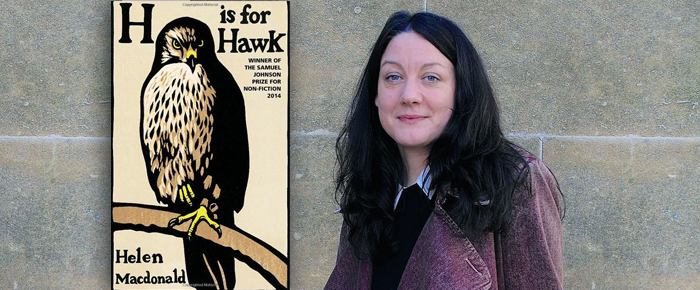
By Heidi Simmons
—–
H is for Hawk
by Helen Macdonald
Nonfiction
—–
Having a close relationship with an animal can be tremendously satisfying. When we love and know a creature, we can be rewarded, changed and inspired in ways our human relationships cannot deliver. In Helen Macdonald’s H is for Hawk (Grove, 288 pages) there are lessons about life, death and freedom.
As young girl of six, author Macdonald had a fascination with falconry. Growing up in England, her parents let her explore the sport mainly through outings and books. Macdonald read everything she could on the subject and hung-out with gentlemen’s falconry clubs learning, observing and training hawks of all kinds.
One book in particular captivated her. Written by T. H. White in 1951 called The Goshawk, Macdonald didn’t understand his hatred and disdain toward the goshawk he raised and trained. (White is also the author of The Sword in the Stone – 1938, The Ill-Made Knight – 1940, The Once and Future King – 1958, The Book of Merlyn – 1977.)
After the unexpected death of her father in London, grieving and alone, Macdonald chooses to adopt a young female goshawk. There is an immediate connection to the bird known to be high-spirited, crazy-wild and exceedingly proud. She names the bird Mable, meaning loveable. Most falconers use names that connote a killer.
Macdonald starts to reconsider what White had said and H is for Hawk becomes an analysis of White’s work. She considers his psychology, his childhood and the influence of England’s cultural history on his writing and thinking.
As Macdonald trains her bird to sit, fly and hunt, she is also forced to take a closer look at death and the grieving process. She begins to understand White differently. He is not a monster but a broken man, damaged by abuse and forced to hide his homosexuality. White, according to Macdonald, finds love and peace in the natural world and with wild animals. So does Macdonald.
By the time Mable is fully grown and ready to molt into a mature bird, Macdonald has moved past her sorrow and has come to have a deep compassion for White and the amazing and difficult bird, Mable the goshawk.
Author Macdonald was a literature major and a Cambridge graduate. She lives with Mable in the vast field area where the university has given her permission to fly her bird. More and more she becomes like White and like a hawk. She is easily agitated, aggressive and recoils from people. Isolated and alone with her grief she finds insight and finally inspiration from her bird.
I particularly appreciated Mable. Through Macdonald the reader sees a magnificent creature mighty and strong. The bird is resilient, independent and deadly. Macdonald is dedicated and desperate to connect with this beast. She learns that being in control is to not be in control.
The language of falconry is fascinating and the constant references to White were interesting. But I wanted more of Mable and less of White. However, I imagine if you are English and love Arthurian lore, this might be more thought-provoking as Macdonald unpacks his imagery and obsession with King Arthur, Merlyn and early British history and mythology. I liked that as a falconer, White, included his experience into his story telling.
The book is powerful as Macdonald comes to literal grips with death when she must kill Mable’s catch — her prey she has returned with. Macdonald tells how she must “harden her heart” to strangle a pheasant or rabbit with her bare hands. Her description is hard to take as she yanks on the bones and twists necks.
Macdonald recognizes that Mable is everything she wants to be: “solitary, self-possessed, free from grief and numb to the hurts of human life.” At one point, Macdonald sees a group of concerned people gathered around a wild animal. She hides in the bushes and observes. After they leave she finds the creature – a rabbit sick with disease – and kills it.
White lived in a cottage surrounded by nature but at one point he didn’t want any more animals. The creatures took too much out of him and yet he couldn’t stand to be separated from them either – it was too painful. He loved animals more than people. Animals could be trusted.
This revelation is the necessary separation from White’s experience for Macdonald. She did not suffer like he had as a child. She had a loving family and good friends. She could move on with her life and still have a relationship with Mable and nature.
Mable gave Macdonald her life back and taught her to live without the fear of loss. She could return to her kind and be part of the world again and live a full and meaningful life. Macdonald moved through her grief and Mable taught her to fly. Creatures can teach us so much if we love and respect them.










































